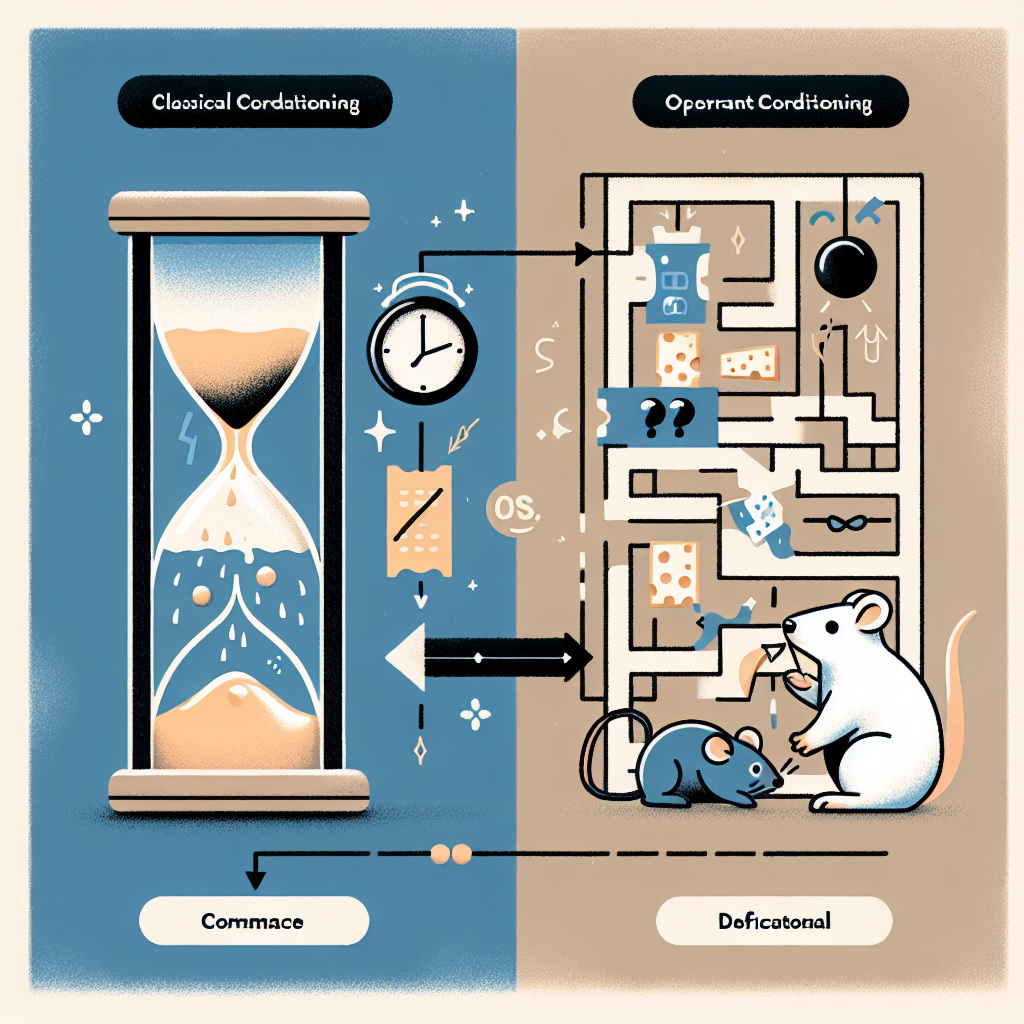
Introduction
Imagine walking into a bakery and instantly feeling hungry, even if you just had lunch. The scent of freshly baked cookies triggers a rush of memories and emotions. This phenomenon can be attributed to classical conditioning, a learning process first identified by Ivan Pavlov. In contrast, consider a child receiving a sticker for completing their homework. This reinforcement leads to an increased likelihood of the child doing homework in the future, showcasing operant conditioning as introduced by B.F. Skinner. Both classical and operant conditioning are powerful psychological principles used to understand behavior and influence learning, making the exploration of classical and operant conditioning: two sides of the stimulus-response coin imperative for educators, psychologists, and anyone interested in human behavior.
In this article, we delve into the nuances of these two conditioning types, explore their applications, and showcase real-world case studies that highlight their significance. We aim to provide you with valuable insights into how these behavioral concepts shape our daily lives and how understanding them can lead to better practices in education, therapy, and much more.
Understanding Classical Conditioning
The Basics of Classical Conditioning
Classical conditioning, pioneered by Pavlov in the early 20th century, occurs when a neutral stimulus becomes associated with a meaningful stimulus, leading to a learned response. For example, when Pavlov rang a bell every time he fed dogs, the canines eventually salivated at the sound of the bell alone. The fundamental components of classical conditioning include:
| Component | Definition |
|---|---|
| Unconditioned Stimulus | Naturally elicits a response (e.g., food). |
| Unconditioned Response | The natural response to that stimulus (e.g., salivation). |
| Conditioned Stimulus | Initially neutral, becomes associated with the unconditioned stimulus (e.g., bell). |
| Conditioned Response | The learned response to the conditioned stimulus (e.g., salivation at the bell). |
Real-World Applications of Classical Conditioning
Advertising: Marketers use classical conditioning to build positive associations with brands. For instance, a catchy jingle (conditioned stimulus) coupled with a product (unconditioned stimulus) can lead consumers to develop a favorable opinion of the product over time.
- Therapeutic Techniques: In behavioral therapy, classical conditioning principles help treat phobias. By gradually exposing a fearful person to the source of their fear (like spiders), combined with positive stimuli (like relaxation techniques), therapists can retrain responses.
Case Study: Little Albert
The famous experiment conducted by John B. Watson and Rosalie Rayner in 1920 involved conditioning a baby, Little Albert, to develop a fear of white rats by associating the rat with loud, frightening noises. This case study exemplifies classical conditioning’s potential impact on behavior and emotions.
Analysis of Little Albert
This study reflects how fears and phobias can develop through learned associations, leading to insights useful in therapy and understanding human emotions.
Unpacking Operant Conditioning
The Fundamentals of Operant Conditioning
Operant conditioning, conceptualized by Skinner, emphasizes the role of reinforcement and punishment in shaping behavior. Unlike classical conditioning, operant conditioning involves active participation and consequences that influence future behaviors. The main elements include:
| Element | Definition |
|---|---|
| Reinforcement | Increases the probability of a behavior recurring (e.g., receiving praise). |
| Punishment | Decreases the likelihood of a behavior occurring (e.g., time-out). |
| Positive Reinforcement | Introducing a pleasant stimulus following a behavior (e.g., rewards). |
| Negative Reinforcement | Removing an unpleasant stimulus (e.g., stopping an annoying sound when a task is completed). |
Applications of Operant Conditioning
Education: Teachers use rewards (like stickers or extra playtime) to reinforce positive behaviors in students, leading to improved classroom behavior and academic performance.
- Animal Training: Dog trainers utilize treats to reward desired behaviors (like sitting on command), which reinforces animals’ learning and compliance.
Case Study: Skinner’s Box
B.F. Skinner’s experiments with rats in a controlled environment (Skinner Box) effectively demonstrated how operant conditioning works. When the rat pressed a lever, a food pellet would be released, leading the rat to increase lever pressing.
Analysis of Skinner’s Box
This case study is pivotal in behavioral psychology as it illustrates how reinforcement can lead to learning and behavior change. It emphasizes the importance of operant methods in behavior modification across various settings.
Similarities and Differences in Conditioning
Comparative Analysis
Both classical and operant conditioning focus on learning, but they differ fundamentally in methods and applications. Here’s a comparison to clarify:
| Feature | Classical Conditioning | Operant Conditioning |
|---|---|---|
| Basis of Learning | Associative learning through stimuli | Learning through consequences of behavior |
| Type of Response | Involuntary, automatic | Voluntary, deliberate |
| Role of Subject | Passive recipient of stimuli | Active participant; behavior influences outcomes |
| Application Context | Emotional responses, reflexes | Behavioral management, habit formation |
The Integration of Theories
Despite their differences, both conditioning types can complement each other in therapeutic and educational environments. For example, classical conditioning can help individuals become accustomed to a setting (like a classroom), while operant conditioning can be employed to encourage engagement through positive reinforcement.
Practical Strategies to Implement Conditioning Principles
Classroom Settings
Use Positive Reinforcement: Reward students with praise or tangible rewards for good behavior to increase the likelihood of that behavior repeating.
- Desensitization Techniques: Apply classical conditioning principles to reduce anxiety in students by gradually introducing them to stressful situations in a controlled manner.
Workplace Applications
Performance Rewards: Implement a system where employees are rewarded for achieving targets, thus increasing their motivation and performance through operant conditioning.
- Employee Engagement Programs: Use classical conditioning by associating positive team-building activities with the workplace environment to foster a happier atmosphere.
Conclusion
Exploring classical and operant conditioning: two sides of the stimulus-response coin reveals the intricate ways our behaviors are shaped and influenced. Understanding these principles offers invaluable insights into human psychology, informing effective strategies for education, therapy, and personal growth.
By utilizing classical conditioning to foster positive emotional responses and operant conditioning to reinforce desired behaviors, we can enhance learning experiences and personal relationships. Whether you’re a teacher, manager, or parent, the applications of these timeless psychological concepts can lead to remarkable changes.
Call to Action
If you found this exploration insightful, consider experimenting with these conditioning techniques in your daily life. Whether it’s applying positive reinforcement at work or using classical conditioning to create memorable learning experiences, the power of conditioning is at your fingertips.
FAQs
What is the main difference between classical and operant conditioning?
- The main difference lies in the nature of the learning process: classical conditioning associates involuntary reflexes with stimuli, while operant conditioning involves voluntary behaviors and their consequences.
Can classical conditioning be used in therapy?
- Yes, classical conditioning techniques can be effective in treating phobias and anxiety by associating fearful stimuli with relaxation techniques.
How does positive reinforcement work in operant conditioning?
- Positive reinforcement involves providing a rewarding stimulus after a desired behavior, increasing the likelihood that the behavior will happen again.
Are there practical applications for classical conditioning in daily life?
- Definitely! It can be applied in everyday situations such as training pets, managing habits, or creating positive associations with specific environments.
- Can operant conditioning lead to negative behaviors?
- Yes, if punitive measures are applied inconsistently or harshly, it can lead to fear or anxiety, which may promote undesired behaviors.
In summary, the exploration of classical and operant conditioning: two sides of the stimulus-response coin not only enhances our understanding of behavior but also provides practical tools for personal and professional development.

















